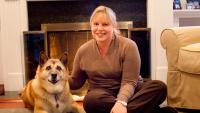Linda's HCM Genes

Linda Lashen's story is a dramatic one: over 17 sudden deaths in her family in four generations, with no apparent cause.
When a teen-aged cousin died suddenly in 1986, a physician performed an autopsy and discovered an abnormal thickening of the septum associated with HCM.
Later, the family was genetically tested. Three out of six siblings were affected—Linda and her two older brothers John and Michael, though none showed any symptoms at the time.
A decade later, Linda, now 27, began to complain of shortness of breath, palpitations, and general fatigue. Within a year, Michael, an internist and pediatrician, died while jogging. Two years later, John died suddenly while in Kazakhstan on business. Both deaths were HCM-related.
"Losing both my brothers like this was devastating," Linda says. "Neither one of them had an implantable defibrillator. In 2004 I received one as a preventative, because of my own heart condition and because of my family history of sudden death"
That same year Michael's medical colleagues suggested the family contact the National Institutes of Health, and with their participation, researchers identified an a-tropomyosin gene mutation that affects HCM patients.
Most people experience an increase in both circulation and heart rate as they exercise. Because of this gene, Linda's cardiac output actually declines as her heart rate goes up, preventing her from exercising.
Hoping to benefit from new treatments for HCM, Linda enrolled in an NIH trial of the drug Losartan. "For a while, this seemed to help. But my health was still very up and down," Linda says. "HCM can be wildly confusing. One day you have a little bit of energy, and the next, you can barely get across the room."
In 2008, Linda's symptoms worsened and she felt exhausted all the time. Since she had no obstruction in her heart, she would not benefit from a myectomy.
Linda had already consulted the top specialists at Tufts, New England Hospital, Mayo Clinic, and the National Institutes of Health. In August, Dr. Frederick Ehlert, a cardiologist at NewYork-Presbyterian Hospital, setup a meeting with Dr. Mathew Maurer, a cardiologist, and Dr. Donna Mancini, a transplant cardiologist.
"It was kind of a shock to think about transplant," Linda says, "but Dr. Maurer asked me to give it serious consideration. He's very sensitive and caring—and great at explaining things in layman's terms."
Dr. Maurer is now closely monitoring Linda's status. In January 2010 Linda's maximum oxygen uptake score went down from 17 to 11 and she was placed on the transplant list.
But through medical management and lifestyle changes, she may have bought herself some time. "In 2011, I started losing weight and this has made a difference. My oxygen uptake is climbing back up to 13, so we're going to test again in a few weeks."
Linda tries to stay as active as she can while she waits for a transplant. She walks her dog, when she's able, and "gives thanks for living so close to doctors who are knowledgeable about HCM."